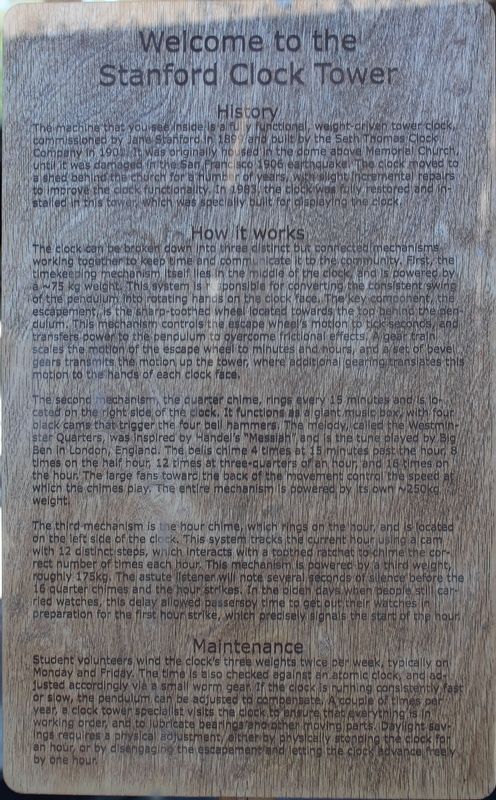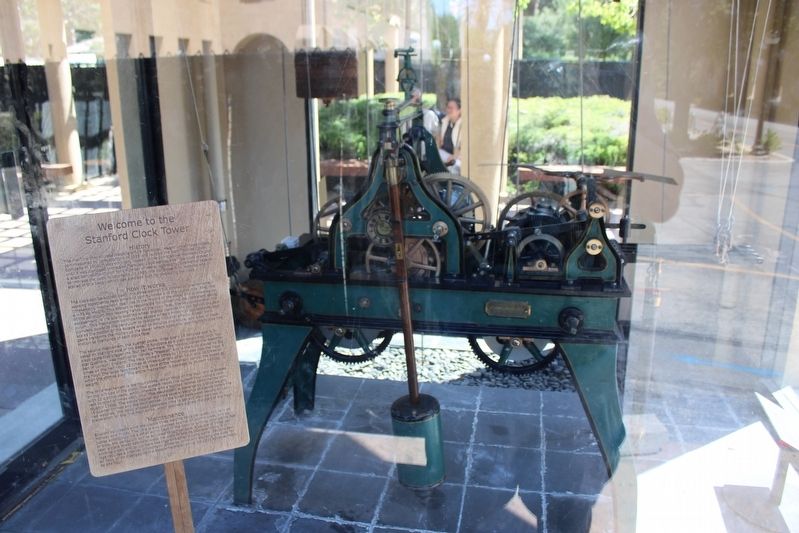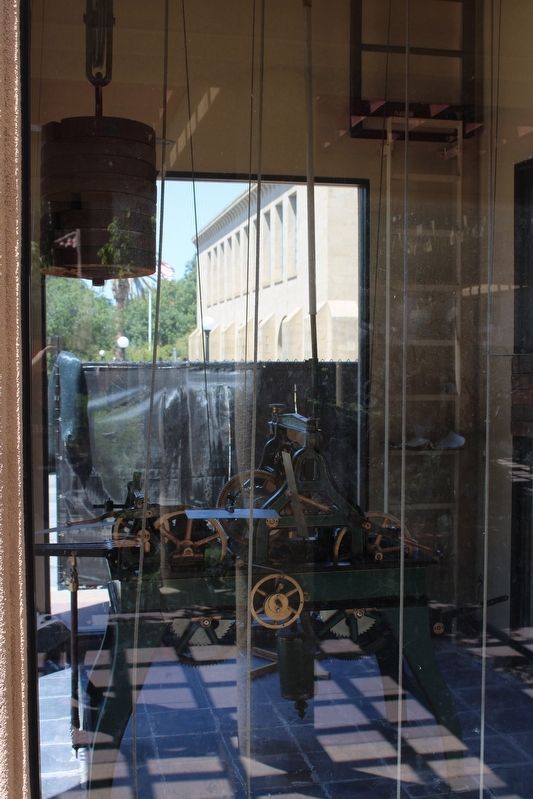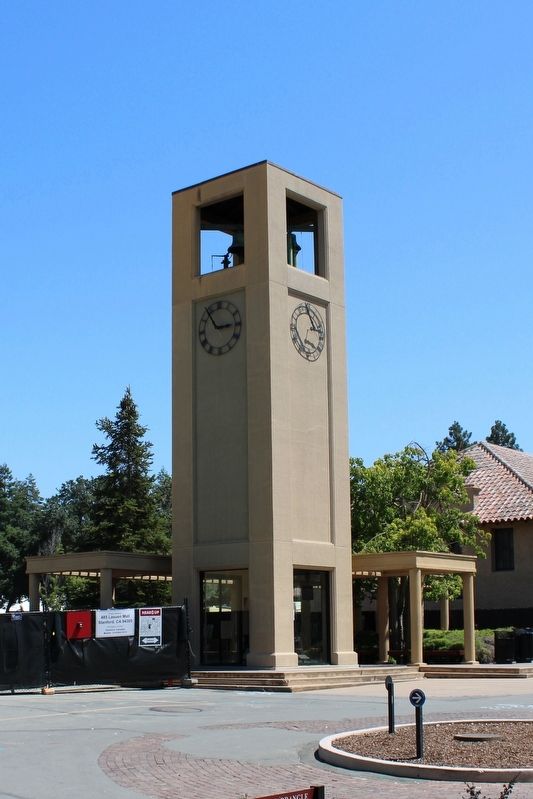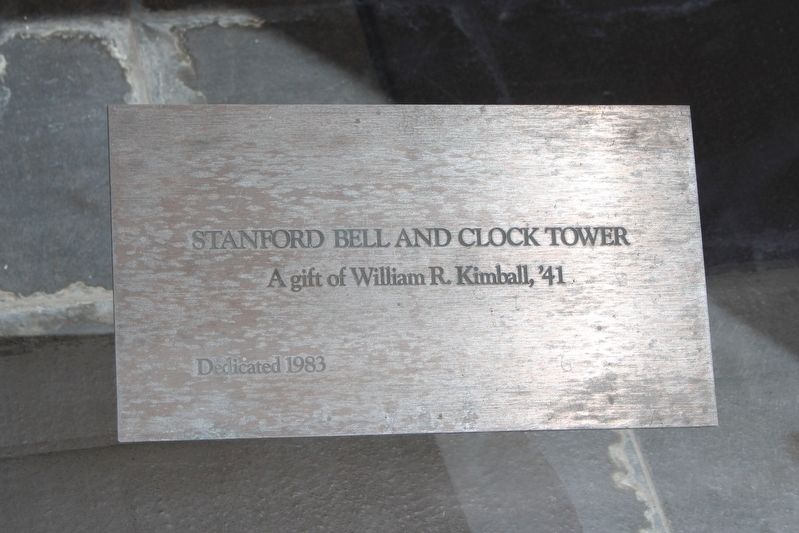Stanford in Santa Clara County, California — The American West (Pacific Coastal)
Welcome to the Stanford Clock Tower
The machine that you see inside is a fully functional weight-driven tower clock, commissioned by Jane Stanford in 1899 and built by the Seth Thomas Clock Company in 1901. It was originally housed in the dome above Memorial Church, until it was damaged in the San Francisco 1906 earthquake. The clock moved to a shed behind the church for a number of years, with slight Incremental repairs to improve the clock functionality. In 1983, the clock wea restored and installed in this tower, which was specially built for displaying the clock.
The clock can be broken down into three distinct but connected mechanisms working together to keep time and communicate it to the community. First, the timekeeping mechanism itself lies in the middle of the clock and is powered by a 75 kg weight. This system is responsible for converting the consistent swing of the pendulum into rotating hands on the clock face. The key component, the escapement is the sharp-toothed wheel located towards the top behind the pendulum. This mechanism controls the escape wheel's motion to tick seconds and transfers power to the pendulum to overcome frictional effects. A gear train scales the motion of the escape wheel to minutes and hours, and a set of bevel gears transmits the motion up the tower, where additional gearing translates this motion to the hands of each clock face.
The second mechanism, the quarter chime, rings every 15 minutes and is located on the right side of the clock. It functions as a giant music box, with four black cams that trigger the four bell hammers. The melody called the Westminster Quarters, was inspired by Handel's "Messiah" and is the tune played by Big Ben in London, England. The bells chime 4 times at 15 minutes past the hour 8 times on the half hour, 12 times at three-quarters of an hour and 16 times on the hour. The large fans toward the back of the movement control the speed at which the chimes play. The entire mechanism is powered by its own 250kg weight.
The third mechanism is the hour chime, which rings on the hour, and is located on the left side of the clock. This system tracks the current hour using a cam with 12 distinct steps, which interacts with a toothed ratchet to chime the correct number of times each hour. This mechanism is powered by a third weight, (roughly 175kg. The astute listener will note several seconds of silence before the 16 quarter chimes and the hour strikes. In the olden days when people still carried watches, this delay allowed passersby time to get out their watches in preparation for the first hour strike, which precisely signals the start of the hour
Student volunteers wind the clock's three weights twice per week, typically on Monday and Friday. The time is also checked against an atomic clock, and adjusted accordingly via a small worm gear. If the clock is running consistently fast or slow, the pendulum can be adjusted to compensate. A couple of times per year, a clock tower specialist visits the clock to ensure that everything is in working order, and to lubricate bearings and other moving parts. Daylight savings requires a physical adjustment, either by physically stopping the clock for an hour, or by disengaging the escapement and letting the clock advance freely by one hour.
Erected by Stanford University.
Topics. This historical marker is listed in this topic list: Communications. A significant historical year for this entry is 1899.
Location. 37° 25.559′ N, 122° 10.133′ W. Marker is in Stanford, California, in Santa Clara County. Marker can be reached from Lasuen Mall south of Esondido Mall, on the right when traveling north. The wood marker is displayed at the base of the clock tower. Touch for map. Marker is at or near this postal address: 450 Jane Stanford Way, Stanford CA 94305, United States of America. Touch for directions.
Other nearby markers. At least 8 other markers are within walking distance of this marker. First Inhabitants: The Ohlone of the Peninsula (about 400 feet away, measured in a direct line); Generations of Diverse Perspectives (about 400 feet away); The Stanford Women’s Clubhouse (about 500 feet away); Restoration of the Stanford Campus (about 800 feet away); The Burghers of Calais (approx. 0.2 miles away); Motion Picture Research Commemoration (approx. 0.2 miles away); Wallenberg Hall (approx. 0.2 miles away); Robert Edouard Pellissier (approx. 0.2 miles away). Touch for a list and map of all markers in Stanford.
Also see . . .
1. Clock wise By Amrita Rao. The Stanford Daily
"Over the years, engineering students added a motor to turn the dial so that the clock would continue to keep accurate time, but the chimes fell completely out of sequence. The clock stood as a relic of Stanford University’s earlier days–sentimental but not particularly useful. By the 1960s, the clock and its bells had disappeared into storage and, for a time, into oblivion."(Submitted on September 3, 2023, by Joseph Alvarado of Livermore, California.)
2. A history of Stanford.
"When Jane Lathrop Stanford and railroad magnate and former California Gov. Leland Stanford lost their only child, Leland, Jr., to typhoid in 1884, they decided to build a university as the most fitting memorial, and deeded to it a large fortune that included the 8,180-acre Palo Alto stock farm that became the campus. They made their plans just as the modern research university was taking form."(Submitted on September 3, 2023, by Joseph Alvarado of Livermore, California.)
Credits. This page was last revised on September 3, 2023. It was originally submitted on September 3, 2023, by Joseph Alvarado of Livermore, California. This page has been viewed 118 times since then and 39 times this year. Photos: 1, 2, 3, 4, 5. submitted on September 3, 2023, by Joseph Alvarado of Livermore, California.
